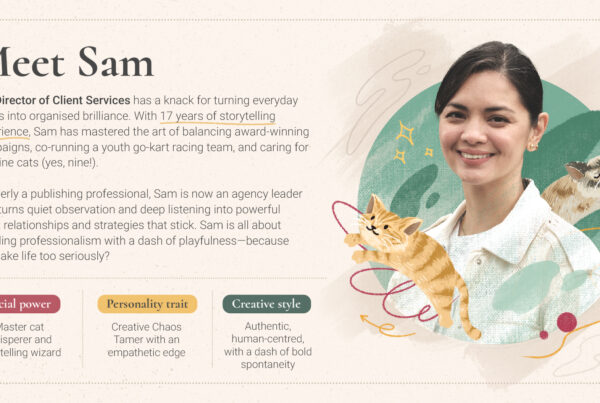As human beings, you’d think that we’d instinctively know how to sound human.
But human beings form organisations. And sometimes, when we write or speak on companies’ behalf, we start thinking and sounding like disembodied entities. We forget that we’re trying to reach people with strong desires and concrete problems.
That’s why entrepreneurs turn to companies like Highspark. Through visual storytelling, they promise to help market leaders win funding, seal business deals, and become #1 in their field. Storytelling, after all, is at the heart of what makes us human (something we firmly believe in at With Content, too).
It’s no surprise that the same premise guides Highspark’s content marketing strategy. After all, a company that claims to make compelling pitches should know how to tell a story.
And this approach has served them well over the years.
Case in point: an article they published in January got a reader to sign an $8,000 contract within a month. It was posted on LinkedIn by Highspark co-founder Eugene Cheng. He used LinkedIn’s Carousel ad format to tell the story in 14 slides, including the title and ‘email us’ pages:
The best part? The reader was three degrees of separation away from Eugene on LinkedIn.
Small wonder that the company is on track to make seven figures for its current financial year. This is partly due to a content strategy that emphasises being human, and knowing who isn’t their audience just as much as who is. As a result, they now produce just three types of content to market their company. (More on that later!)

But before they developed this strategy, they first had to improvise, make mistakes, and learn.
Their first foray into content marketing
In a way, Eugene stumbled upon this strategy—just like how he and his business partner, Kai Xin Koh, discovered the business potential of storytelling almost by chance.
But—as they later learned—you can only improvise for so long.

When Eugene and Kai Xin were business students, they joined business plan competitions, like the NAA Entrepreneur’s Challenge. That’s when they discovered a glaring gap in business education.
“Business students are supposed to be known for their ideas. But in school, we’re not taught the right way to communicate, tell stories, and think about things from the audience’s point of view,” he shares.
He put up some of his work on SlideShare, starting with a deck entitled, 5 BIG tips to Become a Presentation Jedi:
It was a hit. He got emails from people all over the world, asking him for help in creating presentations and telling their companies’ stories – including a large Japanese ad agency.
They had discovered a market for skimmable content. In April 2013, Eugene and Kai Xin set up Slide Comet, a presentation strategy and training company. That became Highspark in September 2015.
Meanwhile, they kept publishing more slide decks on SlideShare, and getting leads in return. They also started email lists and a blog.
Even though they hadn’t heard the term ‘content marketing’ back then, that’s what they were doing.
“We were intuitively applying content marketing techniques without knowing about it,” says Eugene.
Things were going great—Eugene’s personal SlideShare channel plus that of Highspark gained two million views within two years. Their slides were used by Forbes and Hubspot as examples of some of the best presentations out there. As a result, their slides gained a wider audience, and Highspark kept getting more leads.
But when they paused to look at the data, they discovered there was something they had been doing wrong—and it had cost them opportunities.
‘Some very odd keywords’: understanding search terms
In late 2015, Highspark launched a form on their website asking people how they had learned about the company.
The answer surprised them. Around 70 to 80% of people had found them through keyword search, even though they hadn’t been optimising their content for search engines.
That meant their articles and visual content were addressing the problems their audiences were facing. It also showed them the potential reach they could achieve if they would target the right keywords, and reach the right audience through search.
Eventually, in 2017, they hired an SEO consultant. When the consultant had to quit to focus on a full-time job, Eugene bought courses, read blogs, and learned how to do SEO himself.
He uncovered a crucial piece of information that would direct their SEO efforts: people were searching for what Eugene describes as “some very odd keywords” to find them.
For example:
- “make my presentation better”
- “presentation experts”
- “presentation consultants”
- “presentation agency”
While these terms may be familiar to us now, they weren’t that common at the time, especially here in Southeast Asia. It was a niche market, and there were few players.
“We learned that what we want to call it can be very different from the terms audiences are searching for. We refer to ourselves as doing storytelling, but people might search for ‘presentation training’ or a ‘presentation specialist,’” shares Eugene.
As a result, he says that “picking the right words can be very challenging because data is telling you one thing, but at the same time, you want to differentiate yourself.”
Doubling down on SEO
Still, they listened to the data. They adjusted their web copy to reflect both the keywords people were using (i.e. presentation training) and the keywords Highspark wanted to use as part of their branding (i.e. storyteller).
This was coupled with stronger on-page linking infrastructure within the site.
You can still see this in action on their website today:

Highspark also doubled down on link-building.
“We crawled our competitor sites and found out they were ranking for some keywords that were transactional and some for traffic mainly. We reverse-engineered it and produced longer, better articles [using the] skyscraper technique popularised by Brian Dean,” shares Eugene.
(For the curious: the skyscraper technique involves finding link-worthy content, making something better, and reaching out to people who have previously linked to similar content.)
But landing a guest post is tough, especially if you’re relatively unknown. They started by targeting local tech publications like e27 and Vulcan Post, as well as obscure ones like Yellow Pages.
But—as Highspark and their clients know—it takes plenty of time and effort to develop compelling pitches. Eugene shares: “You need to have a unique view on something that will be relevant for the publication you’re pitching for. At the same time, whatever you write largely cannot be promotional.”
He also stresses the importance of understanding each publication’s reader, as well as knowing how the editor likes to work.
And when he didn’t have anything to write about, he reached out to “random experts” to interview them. The interviews became rich sources of content, while the experts’ reputation helped strengthen the articles’ credibility.
They’ve since come a long way. They’ve had more than 75 guest posts, features, and mentions on both local and international online publications. Eugene has been interviewed by the likes of Business Insider and Straits Times, and has written for Tech in Asia, LifeHack, Grow and Convert, and more.
He and Kai Xin have even been recognised among Forbes’ 30 Under 30 in 2020.
Traffic is not everything
Their SEO efforts paid off.
Around mid-2017, their organic traffic began growing in earnest.

They even reached the first page of search engine results for awareness and transactional keywords they were aiming for, such as “presentation agency Singapore”.
This trend continues today, with Highspark’s training page ranking for the keyword “presentation skills training Singapore”, competing for the top spot with major institutions like the British Council and NTUC:

And they grew their backlinks. From 90 unique domains linking to the Highspark site in the beginning of 2017, it tripled to 271 at the start of 2018.

A mediocre marketer would see the rising graphs and rest easy. But like any content marketer worth their salt, Eugene and the team continued to analyse the data.
This time, they found out another crucial piece of information that led to a pivot in their content marketing strategy: more views didn’t lead to more sales.
In fact, their most widely read content—how-tos and listicles—were not bringing in any leads.
They realised that they had made the mistake of reaching too wide. It’s one thing to write good content; quite another to decide whom to write for.
“The only way to reach a specific group of people is to exclude other types of people,” says Eugene.
And so they decided to focus on their core audience—business owners and company executives who could decide whether or not they needed a consultant to help them hone their pitches and presentations.
With their narrower reach, they’re not aiming for volume in views and search, but for conversions.
A strategy emerges: a new criteria for content ideation
With their new focus on conversions, Eugene shares that they’re now more selective in choosing content topics.
“We used to write about anything under the sun as long as it ranked well on search. These days we’re more aware that our targets hail from [the corporate world] and we need to pay more attention to them.”
And if that means reaching a smaller audience, that’s okay, as long as the content ends up converting better. For example, the aforementioned LinkedIn Carousel post that led to an $8,000 contract got only 32 reactions and more than 3,000 views in the four months since Eugene posted it on LinkedIn.
Realising that their target customer were corporate executives also led to the decision to post content more frequently on LinkedIn, instead of just their blog.
So what do they write about these days? Eugene boils it down to three types of content:
- One that celebrates your team or clients
- One that creates value for clients
- One that shows them I’m a friend
1. One that celebrates your team or clients
This type of content “frames the business” by celebrating the team or Highspark’s clients.
Here’s an example:

It tells a story about the team—not about the boss or the company’s services. Eugene has found that readers get interested when he shines the spotlight on his team (“no one wants to read about someone tooting their own horn”).
It’s relatable content that shows the human side of the business, while also implying what the company does. It reminds readers that companies are made of humans, and are not simply abstract entities.
2. One that creates value for clients
This type of content is more familiar in content marketing circles: it’s educational and useful, and packed with concrete steps that readers can take to solve their problems.
The article we mentioned earlier about pitching without a pitch deck is one example. Another is this roughly 2,700-word piece on initial coin offering presentations:
3. One that shows them I’m a friend
This type of content allows Eugene to be forthcoming, vulnerable, and honest about his experiences as an entrepreneur. It resonates with business founders, owners, and executives, who are the target readers.
This retrospective post is an example:
A strategy built on stories
These are the types of content that get results for Highspark. Eugene says that in creating them, they practice the AIDA framework of marketing: capturing attention and interest in order to evoke desire and inspire action.
“The posts show we can deliver that kind of success with clients. And they’re more of human content—not just selling the business, but showing I’m a real person with an interesting story. So even if you don’t want to work with us now, you might want to get in touch and be part of that story,” shares Eugene.
“If there’s no interest and desire, how do we stand out from what everyone else is doing?”
As a result, these types of posts tend to either attract new leads or remind previous clients about Highspark, thereby encouraging reconnection.
Such posts are defined by a clear target audience, and show that they truly get the reader’s struggles.
And they’re all about telling stories. Even the educational pieces follow a narrative based on the reader’s problem and how to solve it. They avoid the mistake made by so many content marketers, which is to drive a hard sell.
That makes perfect sense. As an agency that promises to help “market leaders get their story straight”, “develop high-stakes presentations and narratives”, and “develop the right message, no matter the audience”, one would expect them to live and breathe compelling stories.
Still figuring it out
Highspark’s clearly defined content strategy guides the team’s goals and marketing experiments.
For example, they’ve recently started an interview series called ‘Lead With Stories’, which they publish on their blog. “We interview market leaders who have sold companies, manage teams in some of the world’s leading organisations, and overcome seemingly insurmountable hardships,” says Eugene.
This year, they’re aiming to either maintain their website traffic or increase it by 20%. The more important goal is to get more qualified leads.
To achieve this, they plan to increase their content production to two pieces a week or every two weeks. It helps that they’ve finally hired a copywriter.
They’ll also be producing more thought leadership pieces and videos. And they’re increasingly using LinkedIn’s Carousel format in lieu of SlideShare, which influential marketers now declare to be dead.
Highspark is now in the midst of evolving its services, gunning for higher-ticket offerings. As such, conversion, rather than reach, is crucial.
The winning strategy, however, remains the same: to write content that’s human, and tell compelling stories that create value for readers.
—
200+ industry-leading tech companies in Southeast Asia are happy clients of With Content. Join them and start delivering valuable content to your potential customers today.





